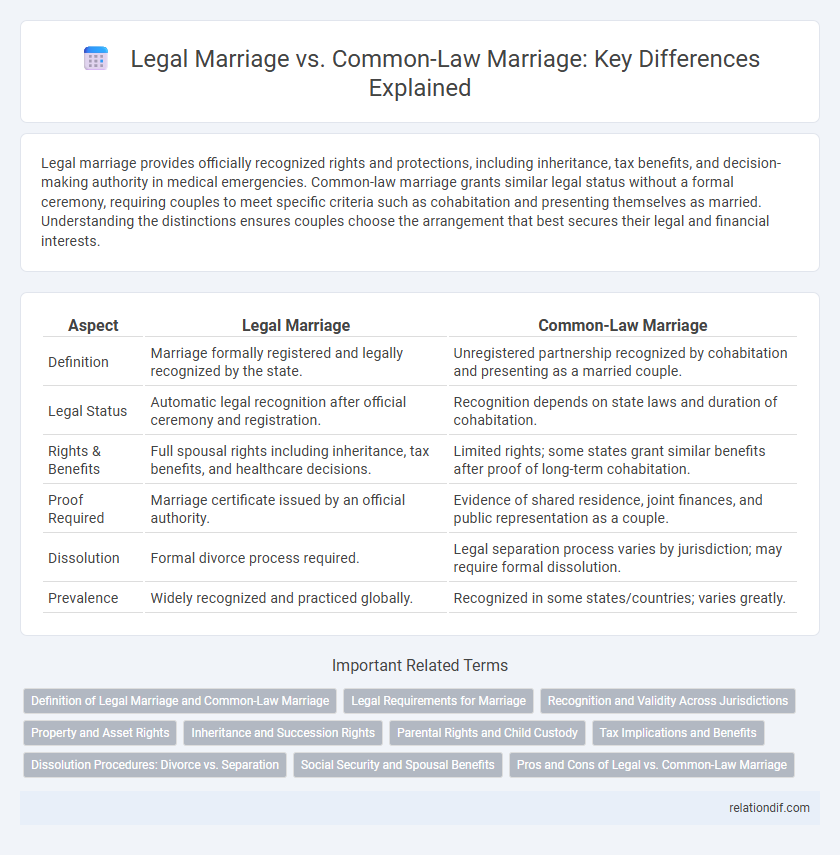Legal marriage provides officially recognized rights and protections, including inheritance, tax benefits, and decision-making authority in medical emergencies. Common-law marriage grants similar legal status without a formal ceremony, requiring couples to meet specific criteria such as cohabitation and presenting themselves as married. Understanding the distinctions ensures couples choose the arrangement that best secures their legal and financial interests.
Table of Comparison
| Aspect | Legal Marriage | Common-Law Marriage |
|---|---|---|
| Definition | Marriage formally registered and legally recognized by the state. | Unregistered partnership recognized by cohabitation and presenting as a married couple. |
| Legal Status | Automatic legal recognition after official ceremony and registration. | Recognition depends on state laws and duration of cohabitation. |
| Rights & Benefits | Full spousal rights including inheritance, tax benefits, and healthcare decisions. | Limited rights; some states grant similar benefits after proof of long-term cohabitation. |
| Proof Required | Marriage certificate issued by an official authority. | Evidence of shared residence, joint finances, and public representation as a couple. |
| Dissolution | Formal divorce process required. | Legal separation process varies by jurisdiction; may require formal dissolution. |
| Prevalence | Widely recognized and practiced globally. | Recognized in some states/countries; varies greatly. |
Definition of Legal Marriage and Common-Law Marriage
Legal marriage is a formal, state-recognized union between two individuals, established through a marriage license and a ceremonial event, granting spouses specific legal rights and responsibilities. Common-law marriage occurs when a couple lives together for a significant period and presents themselves as married without a formal ceremony or marriage license, with state recognition varying by jurisdiction. Understanding the key distinctions between legal and common-law marriage is essential for determining spousal rights, obligations, and legal protections.
Legal Requirements for Marriage
Legal marriage requires a formal ceremony and registration with government authorities, adhering to specific age, consent, and licensing regulations. Common-law marriage, recognized in certain jurisdictions, depends on cohabitation duration and presenting as spouses without official registration. Understanding local laws is essential for confirming the legal status and associated rights of either marital arrangement.
Recognition and Validity Across Jurisdictions
Legal marriage is officially recognized by all jurisdictions and requires a formal marriage license, ceremony, and registration, ensuring uniform validity across regions. Common-law marriage, however, is acknowledged only in specific jurisdictions where couples meet criteria such as cohabitation and presenting themselves as married, leading to inconsistent recognition nationwide or internationally. Understanding the legal distinctions between formal marriage certificates and common-law criteria is crucial for property rights, inheritance, and spousal benefits.
Property and Asset Rights
Legal marriage provides spouses with explicit property and asset rights, including joint ownership, inheritance, and equitable distribution upon divorce, governed by statutory laws. Common-law marriage, recognized in limited jurisdictions, grants similar property rights only after meeting specific criteria such as cohabitation and presenting as married, but may require legal proof to enforce these rights. Asset division in common-law unions often involves complex legal challenges compared to the clearer protections under formal marriage licenses.
Inheritance and Succession Rights
Legal marriage grants spouses automatic inheritance and succession rights protected by state laws, including entitlement to property, pensions, and decision-making authority upon a partner's death. Common-law marriage, recognized in fewer jurisdictions, provides similar inheritance rights only when the relationship meets specific criteria, such as cohabitation duration and public representation as married. Without formal recognition, common-law partners may face legal challenges in claiming inheritance and succession benefits compared to legally married spouses.
Parental Rights and Child Custody
Legal marriage provides automatic parental rights and formal recognition of both parents, simplifying custody arrangements and legal responsibilities. Common-law marriage requires additional proof of partnership for parental rights, as courts may not automatically recognize the relationship, potentially complicating custody decisions. Establishing paternity or legal guardianship is often necessary in common-law unions to secure custody and child support rights.
Tax Implications and Benefits
Legal marriage grants couples access to numerous tax benefits, including filing joint tax returns, eligibility for spousal tax credits, and potential estate tax advantages. Common-law marriages, recognized in certain jurisdictions, allow couples to claim similar tax benefits only if the relationship meets specific state criteria and is legally acknowledged. Failure to establish a common-law marriage can restrict access to these tax advantages, leading to higher tax liabilities and reduced financial protections.
Dissolution Procedures: Divorce vs. Separation
Legal marriage requires formal divorce proceedings through the court system to dissolve the union, involving legal documentation and potential division of assets and custody arrangements. In contrast, common-law marriage dissolution often involves separation without formal divorce, though some jurisdictions may require legal steps to resolve property and custody disputes. Understanding the specific state laws governing common-law marriage dissolution is essential for managing rights and obligations during separation.
Social Security and Spousal Benefits
Legal marriage guarantees spouses access to Social Security benefits such as survivor benefits, spousal retirement benefits, and disability benefits, provided the marriage meets state and federal requirements. Common-law marriage, recognized in a limited number of states, may entitle partners to similar Social Security and spousal benefits if the relationship is legally validated under state law. Understanding eligibility criteria and documentation requirements is crucial for claiming Social Security and spousal benefits in both legal and common-law marriages.
Pros and Cons of Legal vs. Common-Law Marriage
Legal marriage offers clear legal protections including inheritance rights, spousal benefits, and tax advantages, while common-law marriage may lack uniform recognition and requires proof of cohabitation and intent. Common-law marriage provides flexibility and less formal commitment but can create complications in property division and spousal support without formal documentation. Legal marriage ensures well-defined legal status and access to government benefits, whereas common-law status varies by jurisdiction, leading to potential ambiguity in legal rights.
legal marriage vs common-law marriage Infographic

 relationdif.com
relationdif.com